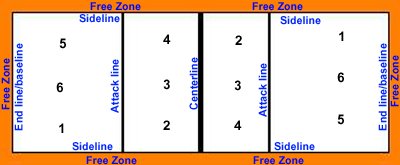Volleyball Serving Strategies
Is serving really that important?
How important is volleyball serving? I'm sure you've heard the volleyball saying, "it all starts with the pass".
Well, I guess that's true, or is it?
For many players, volleyball is an emotional rollercoaster ranging from confidence to frustration. These emotions that players experience from play to play have a big impact on momentum.
Like most sports, winning in volleyball has a great deal to do with momentum.
For example, a player continually builds confidence by making perfect passes. By consistently executing skills, players expect to make great plays.
On the flip side, a player can shank passes over and over again and develop the mind set they can't pass.
Same situation with a hitter that continually puts the ball away or repeatedly gets blocked.
In my opinion, the easiest way to knock a team out of rhythm and keep the momentum of the game going your way is with tough serving.

By volleyball serving tough you can make it much more difficult for your opponent to run the offense. Tough serves can create free ball situations that allow your team to build confidence passing and executing offensive plays.
A team that serves really well can frustrate even the best teams.
Types of Volleyball Serving
Floaters Float serves are tough to pass because the ball dances in the air making it tough to judge where exactly the ball is going. This floating volleyball movement can also make it difficult for the server to keep the ball in the court.
Top spin A top spin can be tough to pass because the ball will drop much faster than a float serve.
Topspin serves are especially effective in the women's game. In girls high school and club volleyball, most players don't serve with top spin. With fewer players serving with top spin, there will be fewer passers comfortable passing it because they hardly ever see it. The top spin serve can be a very effective weapon because it's much easier to learn and execute than the floater.
Volleyball Serving, Giving Your Team the Advantage
Is Serving Zones Really the Best Strategy?
Typically, the court is divided up in to zones, 1 through 6.

Zone 1 is Right Back, zone 2 is Right Front, zone 3 is Middle Front, zone 4 is Left Front, zone 5 is Left Back, and zone 6 is Middle Back.
When first learning how to play, it's good to have your players practice serving accuracy by trying to serve zones.
However, for more advanced volleyball players, I dont like the term court zones when talking about where to serve. Players need to learn to serve making passers move, disrupting the opponent's offense. This should be done not by serving zones, but by making players move the way you want them to. Instead of just hoping your opposition has a hard time passing by serving "court zones", serve to dictate how a passer plays the ball.
If you find these tips useful and would like to keep it close to you at any time, just save this pin to your Pinterest Volleyball Training Board.
Two volleyball serving strategies...
1. Ignore where players are standing on the court and serve certain areas, notzones. If all you ever do is decide where to serve depending on how your opponent is lined up in serve receive, you often play right into their hands.
Develop tough volleyball serving skills for hitting common areas of the court that are tough to pass (deep corners and short).
2. Analyze how your opponent lines up in serve receive. Much like a quarterback in football reads the defense when calling plays, a volleyball server can read the opponent's serve receive. No one knows your abilities to serve better than you do. Factor together what you know you can do, how you feel in that moment, with your opponent's vulnerabilities.
Things to look for...
- How tall are the passers? Short players have a tough time passing deep servers. Taller players usually don't like to be served short.
- How well does the passer move to pass? Watch for how well a player passes when moving to the left or to the right. Many players are stronger passing when moving to one side compared to the other.
- How well does the passer pass the deep serve? Many passers have become comfortable using their hands to overhead pass the deep serve. Other players only try to pass this ball with their forearms. It can be much more difficult to get in position and pass the deep ball with the forearms, especially for shorter players.
Often the best hitter on the team is also one of the best passers. Look to see if a hitter is lined up to help serve receive. You can use this to your advantage by serving them deep pushing them out of the offensive system. - How well does the passer pass the short serve? You will often discover players not wanting to forearm pass and take every ball with their hands. Serve players that like to take the serve with their hands short, forcing them to forearm pass the ball.
Notice if any front row players have backed up to help out with serve receive. You can place your serves in the area of the court that forces the front row player to pass. Forcing front row players to pass can disrupt a teams offense because the front row player will then need to hit after they pass the ball.
Volleyball Serving Related Pages
Volleyball › Volleyball Strategies › Volleyball Serving
